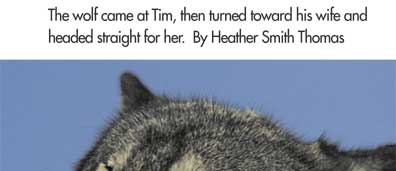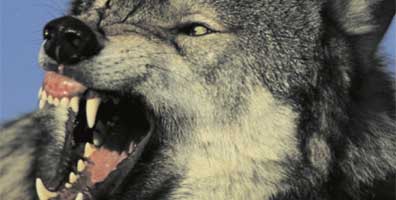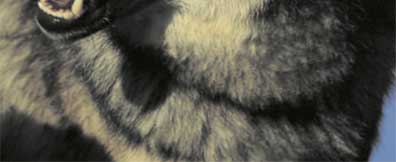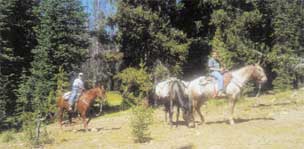|
|
|
| Subscriptions click here for 20% off! | E-Mail: info@rangemagazine.com |
|
||||||||||
|
He turned a couple of head loose to graze and picked up his rifle as they started to walk out of camp, but Tim had an uneasy feeling. “We got about 100 yards out of camp where our two pack animals were grazing and a big grey wolf wassneaking up on them. He was real close, about 15 to 20 feet from them, and they weren’t paying any attention. In the back of my mind was the disquieting thought, ‘Where’s the rest of the pack?’ I had to assume these were the same wolves that were there a couple hours earlier, and there were a bunch of them!” He fired a shot over the wolf, trying to get it to run off, but it just turned on Tim and Diana. They didn’t know at the time it was the alpha male or that it was radio collared. “When I fired the shot over it, it came straight at me, full speed. I fired two more rounds trying to hit it, but a wolf running at you through the trees is really hard to hit. He got within 10 to 15 feet of me then veered off and circled around me. He turned toward my wife on the trail behind me—and was headed straight for her. I had a perfect broadside shot and was able to get my sight on him. He dropped just about 10 feet from my wife.” To avoid being shot Diana had fallen to the ground, because she realized that when the wolf did a semi-circle around Tim, she was in Tim’s line of fire. “I was swinging the gun muzzle right toward her and when she saw that, she got out of the way,” he says quietly. “If she’d been between me and the wolf, there’s no way I could have shot it.” When he saw the radio collar and the ear tags, he thought, “This vacation is over!” At first he decided to keep the incident quiet, but then reconsidered. “One of the big lies the U.S. Fish & Wildlife Service [FWS] and the environmentalists are telling us is that wolves are not dangerous to humans. The longer I thought about that, the more I thought people have a right to know. If I keep this quiet, someone else might get hurt. The next time, it might be a little kid and then I’m going to feel partly responsible.” Tim came home from the camping trip and tried to find an attorney familiar with the Endangered Species Act, but couldn’t. He called county commissioners, legislators—a lot of people—but had no luck finding an attorney who could advise him. “I didn’t want to tell my story and end up being prosecuted. I found out there’s a law that says you’ve got to report the shooting of a wolf within 24 hours. It took us 48 hours to get out of the wilderness. So I was already in violation of that law by the time I found out about it, and I didn’t know what to do.” Because he couldn’t find an attorney he went public, at his own peril. At a mid-August public meeting in Salmon, Ida., Tim Sundles stunned the group with his account of shooting the radio-collared wolf in self defense. He hadn’t planned to speak. He merely wanted to talk with Senator Mike Crapo in private, but halfway through the meeting changed his mind. As one person in the audience recalls, “Sundles was the last speaker. What he told us was so shocking it made everything else insignificant. If he’d spoken earlier on the program, I think it would have ended the meeting right then.” The purpose of the hearing was for input on delisting the thriving population of reintroduced wolves. TimTim Sundles came forward because the Constitution says he has a right to defend himself, his family and his property. “All three of those things were happening up there, and yet, out of fear of the way the government enforces the Endangered Species Act, I didn’t want to come forward. I finally became ashamed of my own cowardice and decided to tell people—and do it with the senator and the media there so I couldn’t be arrested and privately hung. I wanted publicity,” he explains, “because that was my only protection.” After telling his story, FWS agents wanted him to show them the wolf to determine whether he actually shot it in self defense. “My attorney told me I didn’t have to, but I took them up there and we showed them the wolf,
the calf. An autopsy was done on the wolf and calf by local veterinarian Robert Cope. When federal agents arrived, they took both bodies for their own autopsies—and exchanged a stillborn calf for the one the wolf killed, claiming the wolf had not killed the calf. What they didn’t know was that Cope had a videotape of the original autopsy. “He had indisputable evidence that the calf was live born,” says Tim. “The feds didn’t know about that tape. When they found out, they knew they’d hung themselves; it showed they were not honest,” Tim continues. “So I did a like thing; I made some safety precautions. I don’t think the feds are going to falsify
Just recently, Tim Sundles and a friend went elk hunting, taking along a guard for their horses and mules. Where there were previously plenty of elk they were now scarce, but wolves were abundant, howling to one another in the night and sighted in packs as large as a dozen. Heather Smith Thomas is a writer and rancher from Salmon, Ida. |
||||||||||
|
To Subscribe: Please click here or call 1-800-RANGE-4-U for a special web price Copyright © 1998-2005 RANGE magazine For problems or questions regarding this site, please contact Dolphin Enterprises. last page update: 04.03.05 |
|||






